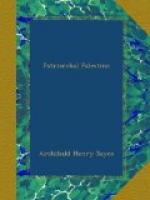With the lists of Ramses III. our knowledge of the geography of Patriarchal Palestine is brought to a close. Henceforward we have to do with the Canaan of Israelitish conquest and settlement. The records of the Old Testament contain a far richer store of geographical names than we can ever hope to glean from the monuments of Egypt. But the latter show how little change after all was effected by the Israelitish conquest in the local nomenclature of the country. A few cities disappeared like Kirjath-Sepher, but on the whole not only the cities, but even the villages of pre-Israelitish Canaan survived under their old names. When we compare the names of the towns and villages of Judah enumerated in the Book of Joshua with the geographical lists of a Thothmes or a Ramses, we cannot but be struck by the coincidences between them. The occurrence of a name like Hadashah, “the New (Land),” in both cannot be the result of chance. It adds one more to the many arguments in favour of the antiquity of the Book of Joshua, or at all events of the materials of which it consists. Geography, at all events, gives no countenance to the theory which sees in the book a fabrication of later date. Even the leading cities of the Israelitish period are for the most part already the leading cities of the earlier Palestine. The future capital of David, for example, was already called Jerusalem long before the birth of Moses, and already occupied a foremost place among the kingdoms of Canaan.
CHAPTER VI
CANAANITISH CULTURE AND RELIGION
We have already learned from the annals of Thothmes III. how high was the state of civilization and culture among the merchant princes of Canaan in the age of the eighteenth Egyptian dynasty. Artistically finished vases of gold and silver, rich bronzes, furniture carved out of ebony and cedar, and inlaid with ivory and precious stones—such were some of the manufactures of the land of Palestine. Iron was excavated from its hills and wrought into armour, into chariots, and into weapons of war; while beautifully shaped vessels of variegated glass were manufactured on the coast. The amber beads found at Lachish point to a trade with the distant Baltic, and it is possible that there may be truth after all in the old belief, that the Phoenicians obtained their tin from the isles of Britain. The mines of Cyprus, indeed, yielded abundance of copper, but, so far as we know, there were only two parts of the world from which the nations of Western Asia and the Eastern Mediterranean could have procured the vast amount of tin needed in the Bronze Age—the Malayan Peninsula and Cornwall. The Malayan Peninsula is out of the question—there are no traces of any commercial intercourse so far to the East; and it would seem, therefore, that we must look to Cornwall for the source of the tin. If so the trade would probably have been overland, like the amber trade from the Baltic.




